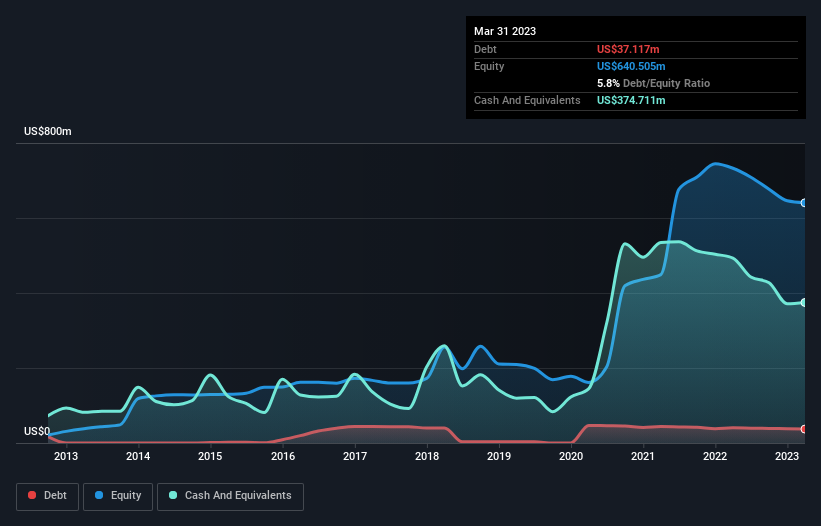- United States
- /
- Specialty Stores
- /
- NYSE:BYON
We Think Overstock.com (NASDAQ:OSTK) Can Stay On Top Of Its Debt

Warren Buffett famously said, 'Volatility is far from synonymous with risk.' So it seems the smart money knows that debt - which is usually involved in bankruptcies - is a very important factor, when you assess how risky a company is. We note that Overstock.com, Inc. (NASDAQ:OSTK) does have debt on its balance sheet. But the more important question is: how much risk is that debt creating?
What Risk Does Debt Bring?
Debt and other liabilities become risky for a business when it cannot easily fulfill those obligations, either with free cash flow or by raising capital at an attractive price. Part and parcel of capitalism is the process of 'creative destruction' where failed businesses are mercilessly liquidated by their bankers. While that is not too common, we often do see indebted companies permanently diluting shareholders because lenders force them to raise capital at a distressed price. Of course, debt can be an important tool in businesses, particularly capital heavy businesses. The first thing to do when considering how much debt a business uses is to look at its cash and debt together.
View our latest analysis for Overstock.com
What Is Overstock.com's Net Debt?
The image below, which you can click on for greater detail, shows that Overstock.com had debt of US$37.1m at the end of March 2023, a reduction from US$40.5m over a year. But on the other hand it also has US$374.7m in cash, leading to a US$337.6m net cash position.

How Healthy Is Overstock.com's Balance Sheet?
The latest balance sheet data shows that Overstock.com had liabilities of US$206.1m due within a year, and liabilities of US$40.8m falling due after that. On the other hand, it had cash of US$374.7m and US$22.1m worth of receivables due within a year. So it actually has US$149.9m more liquid assets than total liabilities.
This surplus suggests that Overstock.com has a conservative balance sheet, and could probably eliminate its debt without much difficulty. Simply put, the fact that Overstock.com has more cash than debt is arguably a good indication that it can manage its debt safely.
In fact Overstock.com's saving grace is its low debt levels, because its EBIT has tanked 94% in the last twelve months. When it comes to paying off debt, falling earnings are no more useful than sugary sodas are for your health. There's no doubt that we learn most about debt from the balance sheet. But ultimately the future profitability of the business will decide if Overstock.com can strengthen its balance sheet over time. So if you want to see what the professionals think, you might find this free report on analyst profit forecasts to be interesting.
But our final consideration is also important, because a company cannot pay debt with paper profits; it needs cold hard cash. While Overstock.com has net cash on its balance sheet, it's still worth taking a look at its ability to convert earnings before interest and tax (EBIT) to free cash flow, to help us understand how quickly it is building (or eroding) that cash balance. Over the last three years, Overstock.com actually produced more free cash flow than EBIT. That sort of strong cash generation warms our hearts like a puppy in a bumblebee suit.
Summing Up
While we empathize with investors who find debt concerning, you should keep in mind that Overstock.com has net cash of US$337.6m, as well as more liquid assets than liabilities. The cherry on top was that in converted 109% of that EBIT to free cash flow, bringing in -US$43m. So we are not troubled with Overstock.com's debt use. When analysing debt levels, the balance sheet is the obvious place to start. But ultimately, every company can contain risks that exist outside of the balance sheet. Case in point: We've spotted 3 warning signs for Overstock.com you should be aware of.
At the end of the day, it's often better to focus on companies that are free from net debt. You can access our special list of such companies (all with a track record of profit growth). It's free.
Valuation is complex, but we're here to simplify it.
Discover if Beyond might be undervalued or overvalued with our detailed analysis, featuring fair value estimates, potential risks, dividends, insider trades, and its financial condition.
Access Free AnalysisHave feedback on this article? Concerned about the content? Get in touch with us directly. Alternatively, email editorial-team (at) simplywallst.com.
This article by Simply Wall St is general in nature. We provide commentary based on historical data and analyst forecasts only using an unbiased methodology and our articles are not intended to be financial advice. It does not constitute a recommendation to buy or sell any stock, and does not take account of your objectives, or your financial situation. We aim to bring you long-term focused analysis driven by fundamental data. Note that our analysis may not factor in the latest price-sensitive company announcements or qualitative material. Simply Wall St has no position in any stocks mentioned.
About NYSE:BYON
Beyond
Operates as an e-commerce affinity marketing company in the United States and Canada.
Good value slight.
Similar Companies
Market Insights
Community Narratives


